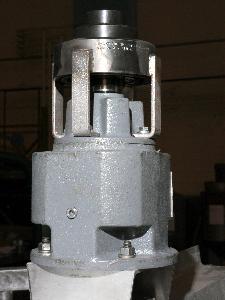
ARCS – Access Rate Control System
Y-12 National Security Complex
Contact Y12 About This Technology
The Access Rate Control System (ARCS) system is a fully mechanical, ready-to-install kit that controls the speed of a person’s entry through full-height turnstiles. The faster the entry speed, the more resistance is generated by ARCS on the rotor to slow the operator.
At a preset normal entry speed, the operator can pass through with minimal rotor force, and ARCS freewheels on exit. All internal components are furnished in a weather-protected steel housing. This low-cost kit can be installed quickly on new or existing turnstiles, cost-effectively providing a new layer of security.
- Fully mechanical, ready to install kit
- Automatic response to rotation speed
- Weather-protected stainless steel housing
- Customizable design that works with various turnstile models
- Permanently lubricated, sealed gearing
- No tension adjustments or sensitivity alignments in the field
- Controlled entry speeds; exit speeds unaffected
- Quick installation, low maintenance
- Cost-effective security
- No external power/control circuitry needed
- Law enforcement
- Military
- Penitentiaries
- Border crossings
- Airports
- Perimeter security
Inventor - Lee Bzorgi
2007 Government Use Award winner
Video - http://www.y12.doe.gov/library/gallery/video.php?mov=arcs&w=430&h=330&v=8
ID Number |
Title and Abstract | Primary Lab |
Date |
|---|---|---|---|
Patent 8,136,297 |
Speed control system for an access gate
An access control apparatus for an access gate. The access gate typically has a rotator that is configured to rotate around a rotator axis at a first variable speed in a forward direction. The access control apparatus may include a transmission that typically has an input element that is operatively connected to the rotator. The input element is generally configured to rotate at an input speed that is proportional to the first variable speed. The transmission typically also has an output element that has an output speed that is higher than the input speed. The input element and the output element may rotate around a common transmission axis. A retardation mechanism may be employed. The retardation mechanism is typically configured to rotate around a retardation mechanism axis. Generally the retardation mechanism is operatively connected to the output element of the transmission and is configured to retard motion of the access gate in the forward direction when the first variable speed is above a control-limit speed. In many embodiments the transmission axis and the retardation mechanism axis are substantially co-axial. Some embodiments include a freewheel/catch mechanism that has an input connection that is operatively connected to the rotator. The input connection may be configured to engage an output connection when the rotator is rotated at the first variable speed in a forward direction and configured for substantially unrestricted rotation when the rotator is rotated in a reverse direction opposite the forward direction. The input element of the transmission is typically operatively connected to the output connection of the freewheel/catch mechanism. |
Y-12 National Security Complex | 03/20/2012
Issued |
| Technology ID | Development Stage | Availability | Published | Last Updated |
|---|---|---|---|---|
| 2078 | Production - TRL 9 - Actual application of the technology in its final form and in Y-12 production use. | Available | 03/28/2011 | 12/06/2016 |






